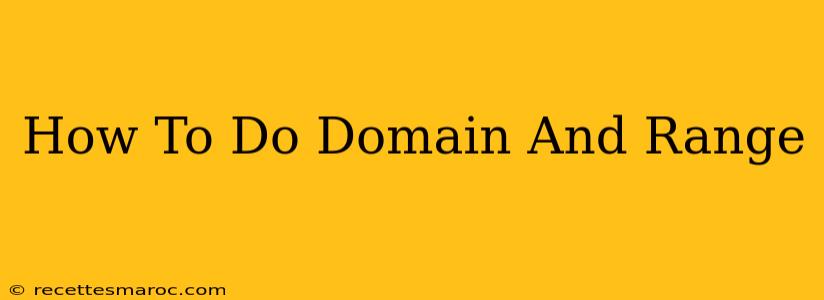Understanding domain and range is fundamental to grasping functions in algebra and beyond. This guide will break down how to find the domain and range of various functions, from simple linear equations to more complex ones. We'll use clear examples and explanations to make it easy to understand.
What are Domain and Range?
Before we dive into the methods, let's define our key terms:
-
Domain: The domain of a function is the set of all possible input values (usually 'x') for which the function is defined. Think of it as the acceptable inputs the function can handle.
-
Range: The range of a function is the set of all possible output values (usually 'y') that the function can produce. These are the results you get after feeding the function the values from its domain.
Finding the Domain and Range: Step-by-Step Examples
Let's explore different types of functions and how to determine their domain and range:
1. Linear Functions (e.g., y = 2x + 1)
Linear functions are the simplest. They usually have a domain and range of all real numbers.
- Domain: (-∞, ∞) This means all numbers from negative infinity to positive infinity.
- Range: (-∞, ∞) Similarly, the output can be any real number.
2. Quadratic Functions (e.g., y = x² + 2x + 1)
Quadratic functions (parabolas) have some subtleties:
- Domain: (-∞, ∞) Again, you can input any real number.
- Range: This depends on whether the parabola opens upwards or downwards.
- Opens upwards: The range starts at the vertex's y-coordinate and goes to infinity. For y = x² + 2x + 1 (which opens upwards), the vertex is (-1, 0), so the range is [0, ∞).
- Opens downwards: The range starts at negative infinity and ends at the vertex's y-coordinate.
3. Rational Functions (e.g., y = 1/x)
Rational functions are fractions where the numerator and denominator are polynomials. Here, we must consider restrictions:
- Domain: The denominator cannot equal zero. So, for y = 1/x, x ≠ 0. The domain is (-∞, 0) U (0, ∞). The "U" symbol means "union," indicating two separate intervals.
- Range: Similarly, the range excludes the value that would make the denominator zero after solving for x. In this case, y can be any value except 0. Therefore, the range is (-∞, 0) U (0, ∞).
4. Radical Functions (e.g., y = √x)
Radical functions (involving square roots, cube roots, etc.) also have restrictions:
- Domain: For even roots (like square roots), the expression inside the radical must be non-negative. So, for y = √x, x ≥ 0. The domain is [0, ∞).
- Range: For y = √x, the output is always non-negative, so the range is [0, ∞).
5. Functions with Piecewise Definitions
Piecewise functions are defined differently across different intervals. You need to analyze the domain and range for each piece and combine them.
Example:
f(x) = { x + 1, if x < 0
{ x², if x ≥ 0
- Domain: (-∞, ∞) Because the function is defined for all real numbers.
- Range: [0, ∞) Since the function only produces non-negative values.
Tips for Finding Domain and Range
- Identify potential restrictions: Look for denominators (can't be zero), even roots (must be non-negative), and logarithms (argument must be positive).
- Graph the function: A graph can visually help determine the domain and range.
- Consider the function's behavior: Think about how the function behaves as x approaches infinity and negative infinity.
Mastering domain and range is crucial for understanding function behavior and solving related problems. By carefully analyzing the function's definition and considering potential restrictions, you can accurately determine its domain and range. Remember to practice with various examples to solidify your understanding.

